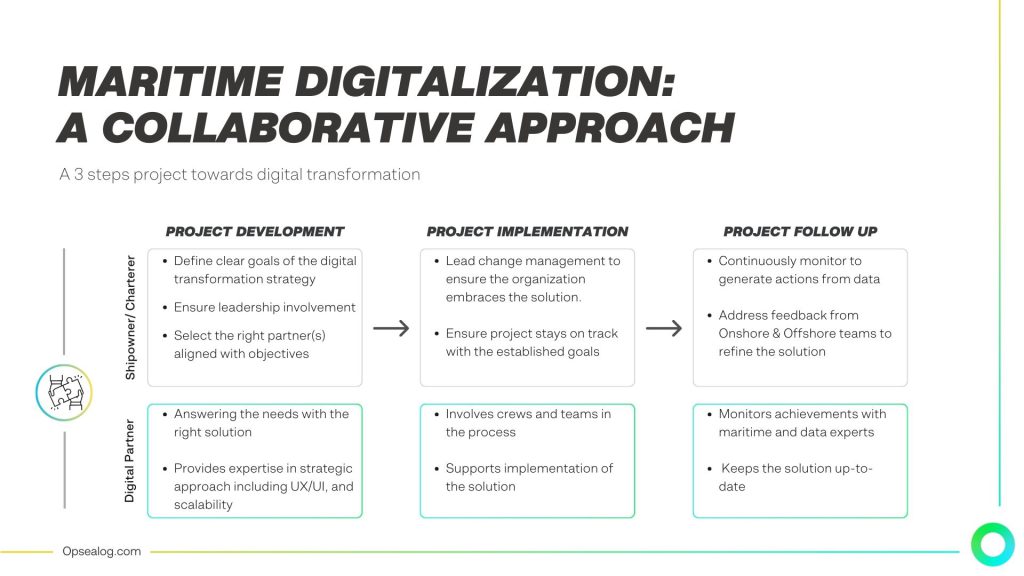Digital transformation in shipping or offshore operations only succeeds when objectives are clear. Too often, stakeholders invest in broad solutions hoping they will solve everything at once: logistics, crew management, vessel performance, reporting, and end up frustrated. The key is to define what you want to achieve first, prioritize your goals, and then build the program around them.
The maritime data ecosystem is fragmented. Information comes from multiple systems, definitions differ between teams, and day-to-day operations generate noise. Without clear objectives, it is impossible to know which data to track, which processes to adjust, or which metrics truly matter.
The potential behind maritime digitalization is real and accelerating. Recent estimates place the global market at approximately USD 220.3 billion in 2025, with forecasts predicting growth to USD 333.5 billion by 2029 at nearly 11% annual growth (ResearchAndMarkets, 2025).
Why clarity and prioritization matter
The first question is not which product to buy but what will actually change when the project succeeds. Do you need more reliable evidence for charter-party delivery? Better fuel performance by task type? Faster reconciliation of engine hours against maintenance plans? Any combination of these objectives can be pursued, but each must be clearly defined. Describe each objective in operational terms, assign a responsible owner, and agree on how success will be measured before any implementation begins.
Clear objectives have three immediate benefits:
- They narrow down which data sources matter.
- They reduce the scope of analytics and interfaces required.
- They create a direct way to demonstrate value.
Digital initiatives are widely recognized as strategic priorities. In a 2025 survey by DCSA and the World Ports Organization, 86% of cargo owners indicated that digitalisation improves operational efficiency, yet only 66% felt confident they had the resources or knowledge to implement it effectively (World Ports Organization, 2025). This highlights why clear objectives and trusted execution are essential.
Be ready before you buy
Before selecting a solution, check three practical areas.
First, assess maturity to launch a digital project. Map the systems that currently produce data. Identify the processes that must change to make the data useful. Assess how your fleet currently manages data and identify pain points.
Second, confirm resources and involvement. Investing in additional hardware is optional in many cases. What is required is a dedicated team that can review outputs and act on them. That team should include operations, technical staff, and a data lead who makes decisions. Executive support matters. Projects with clear senior sponsorship move faster and resolve conflicts before they stall.
Third, define the benefits you expect to get. Specify the insights you want before automating workflows. A stepwise path that begins with analysis and moves toward automated actions reduces risk and accelerates learning.
A three-step project towards digital transformation
A successful digital transformation in offshore operations does not happen overnight. It requires a clear, structured path where every stage is built on the previous one. This process can be understood in three key phases:
- Project Development
The foundation lies in defining clear goals for the digital strategy and ensuring leadership involvement from the very start. Choosing the right partner is equally critical, as they bring expertise in user experience, scalability, and long-term strategic alignment. At this stage, it is also essential to match solutions directly to the operational needs identified, ensuring the project is not technology-driven but purpose-driven. - Project Implementation
Once the direction is set, the focus shifts to execution. Crews and teams on board and onshore must be actively involved, ensuring the solution fits seamlessly into daily operations. Implementation support plays a vital role in overcoming resistance, solving technical hurdles, and embedding the new tools into workflows without disrupting operations. - Adoption and Change Management
Technology only delivers impact if people use it. Change management has become central here, fostering engagement, trust, and ownership among staff. Regular feedback loops ensure that the solution evolves in line with expectations while keeping the project on track with the initial goals. Adoption is not the end of the process but the point at which the transformation truly becomes part of the company’s DNA.

How to effectively manage different objectives
You can pursue several objectives simultaneously if you treat them as a portfolio. Give each objective an owner, define the metric set, and sequence the work. Stabilize shared data sources once and reuse them across workstreams. For example, run parallel streams for data quality, fuel performance, and cost visibility. Each stream should deliver measurable outcomes in its own review cadence. Shared success builds confidence for broader integration.
A capable digital partner helps you organize that portfolio. They should translate objectives into measurable tasks, validate data sources, and explain how each metric is calculated in plain language. They should be able to prove impact quickly and provide a clear scaling path, preserving data consistency as the program grows
Why Choosing the Right Partner Matters
The path from vision to execution is rarely linear, and this is where the role of the digital partner becomes decisive. Maritime operations demand solutions that are not only technically sound but also designed to scale, adapt, and deliver lasting value. The right partner understands these operational realities and can provide both the expertise and the methodology to keep a project aligned with its objectives over time.
At Opsealog, we have seen firsthand how difficult it can be for companies to navigate digitalization alone. Our approach combines deep knowledge of offshore operations with years of experience supporting offshore and ashore crews during every stage of implementation. This means we know what works, what often fails, and how to design solutions that deliver long-term results. By bridging strategy, technology, and change management, we ensure that digital transformation projects succeed.
As Damien Bertin, our Business Director, often says, success depends on using “the right data points … for the right objectives.”(Transport and Logistics Magazine,2024 ).

